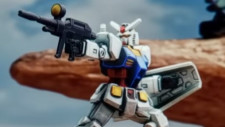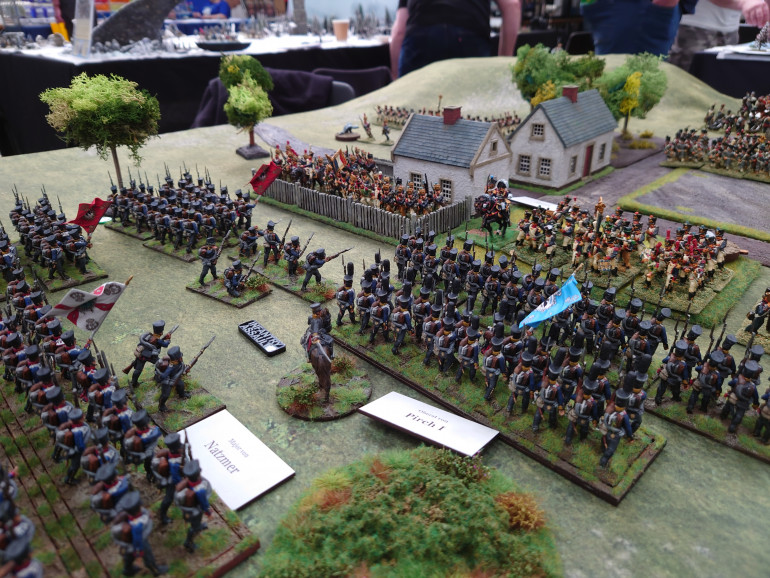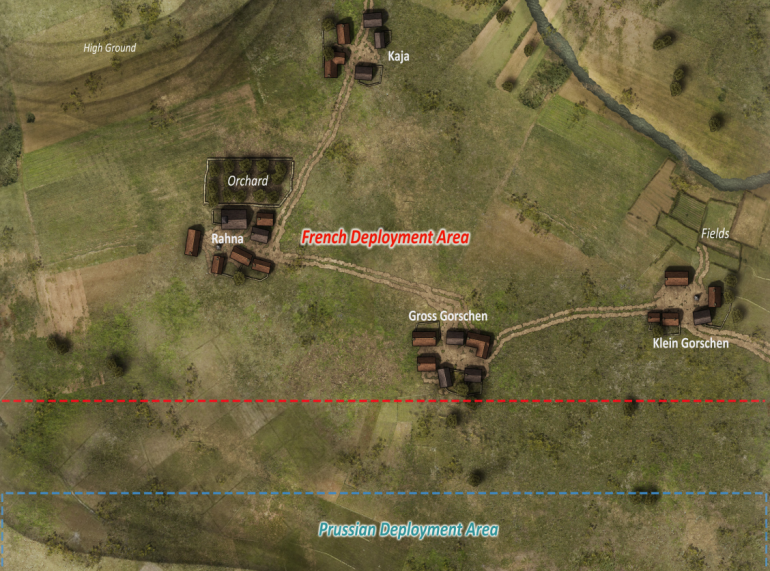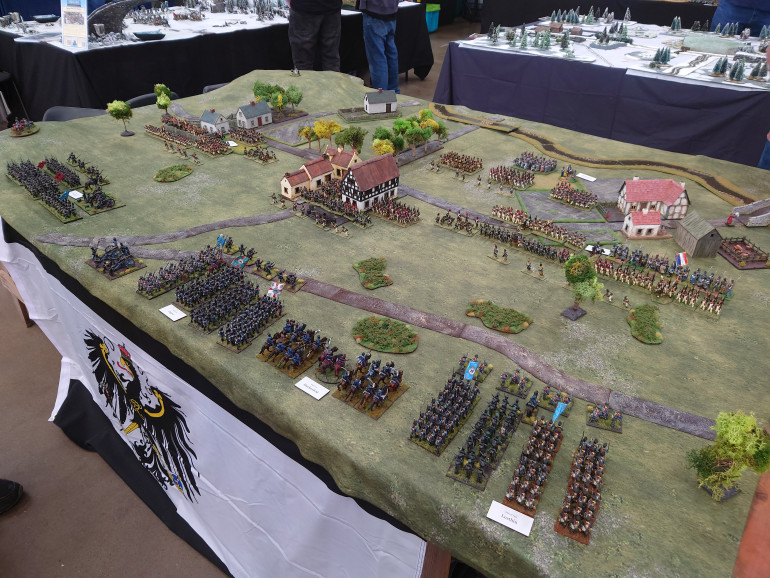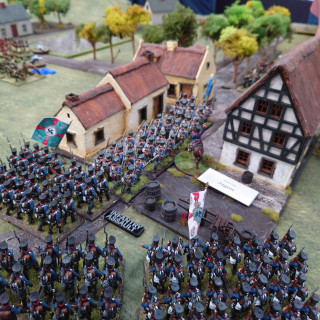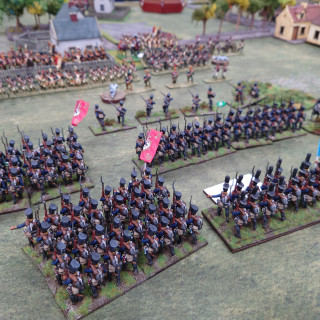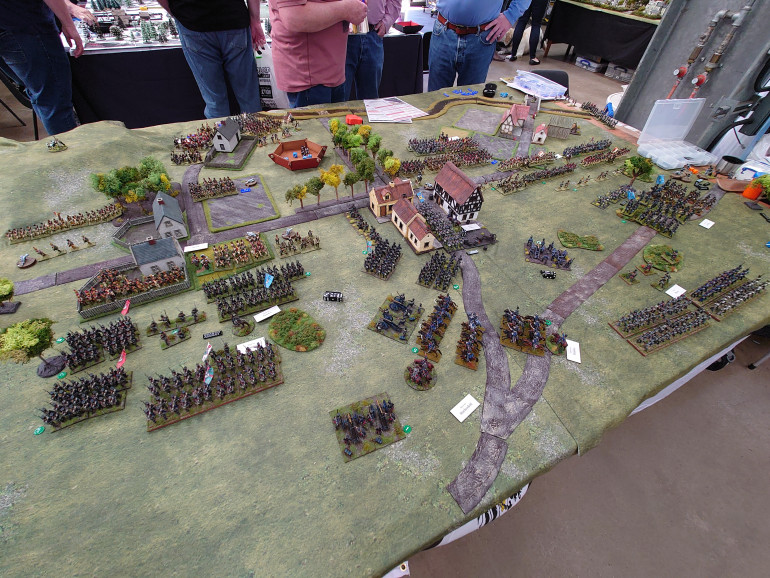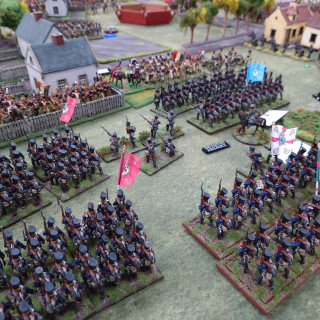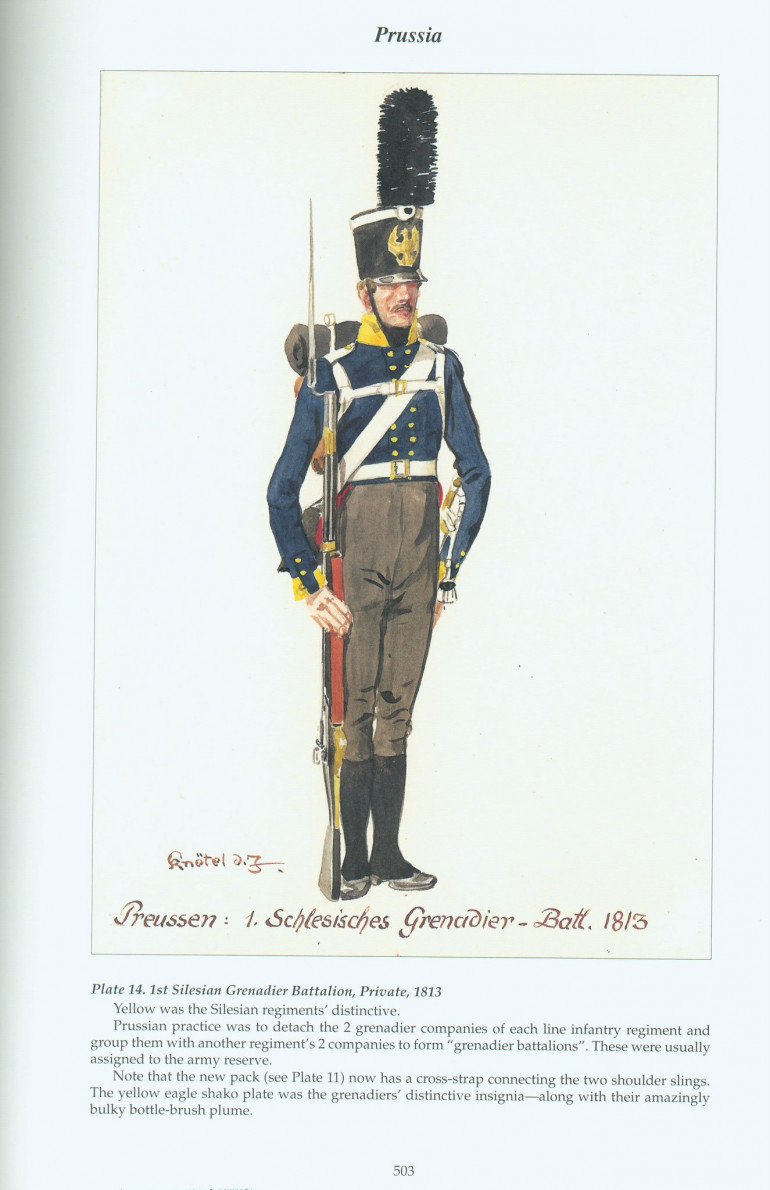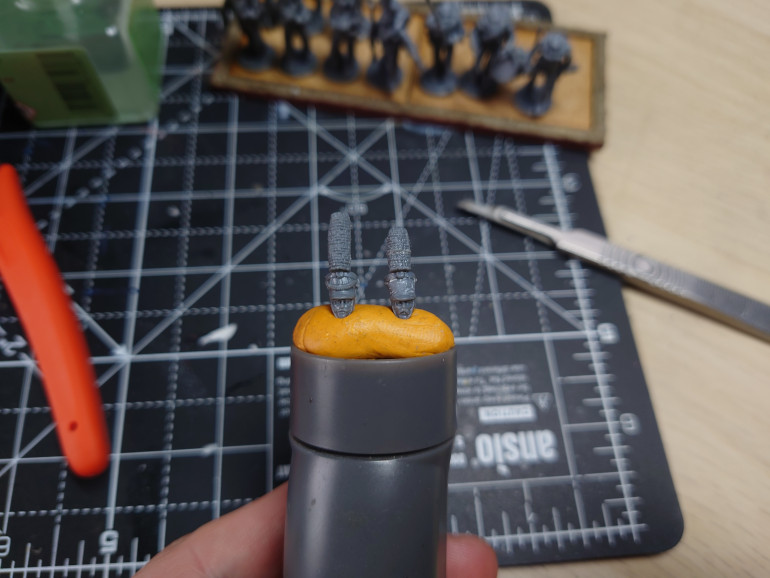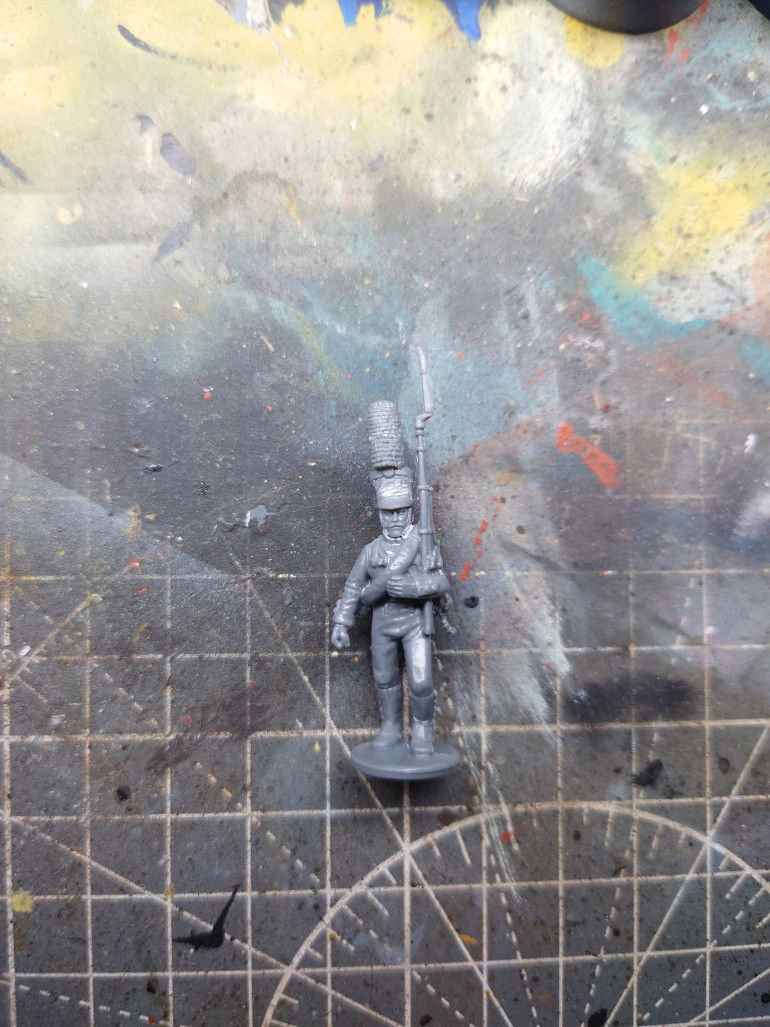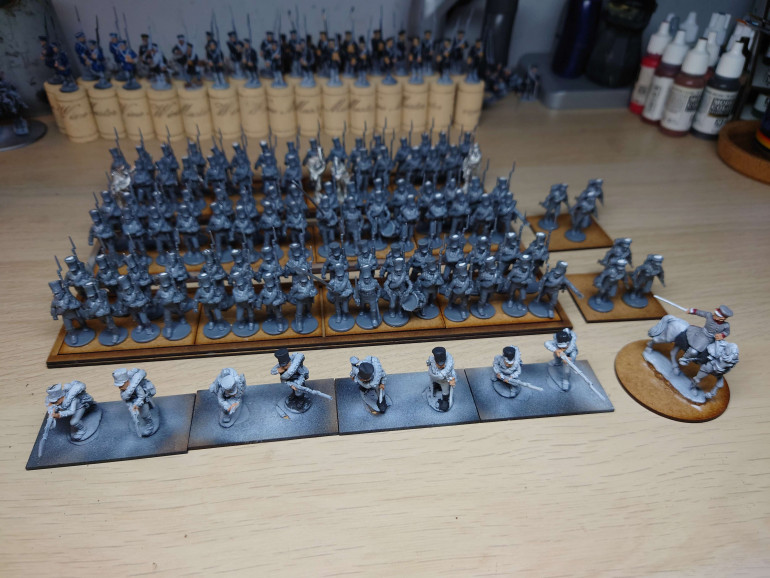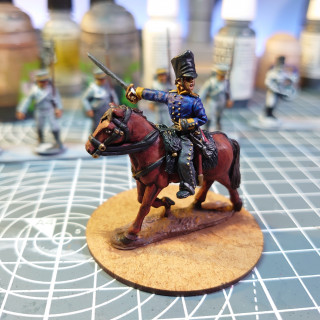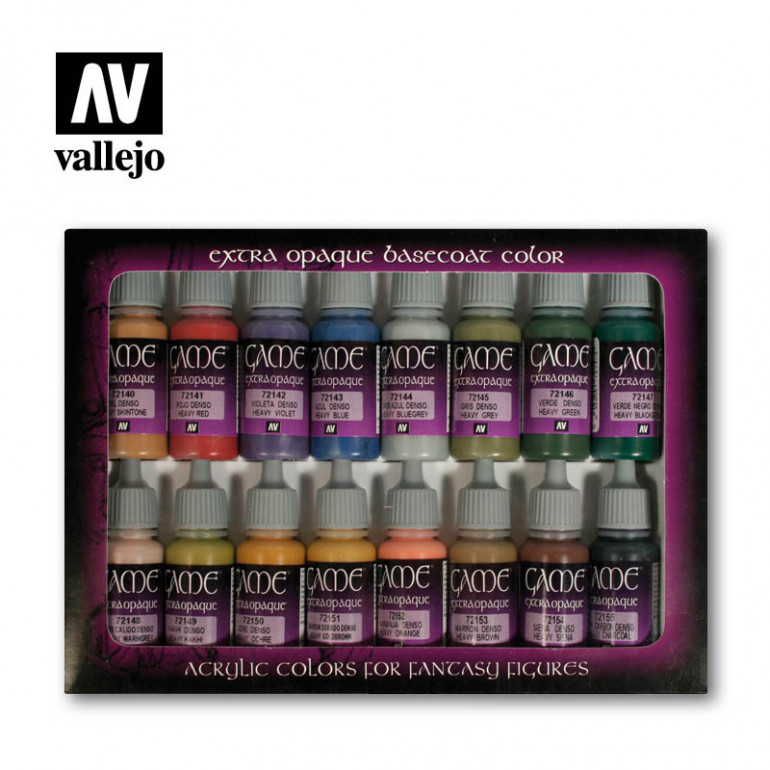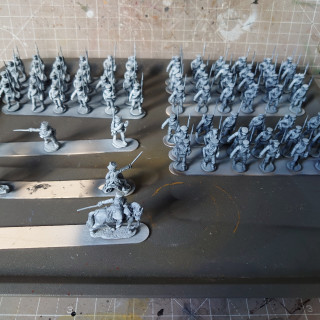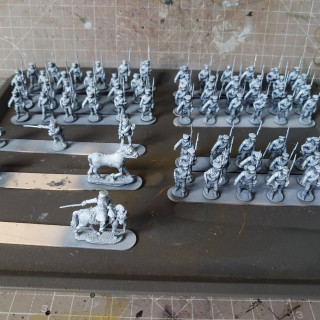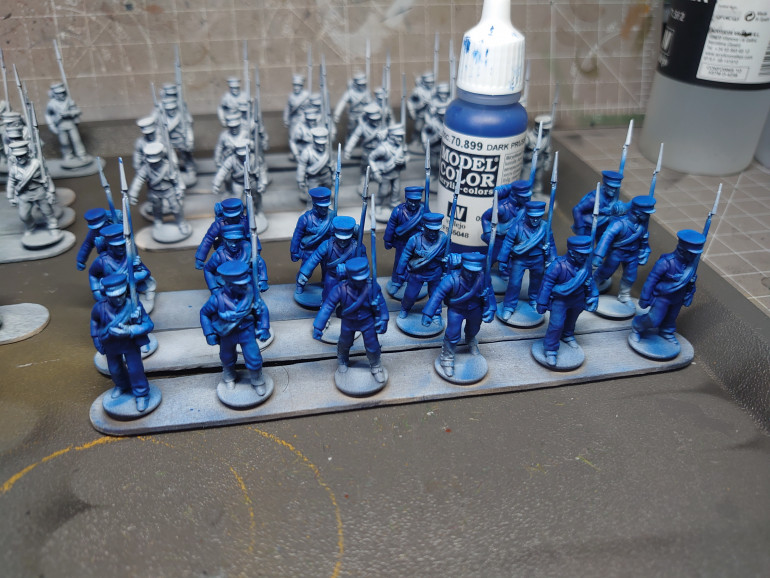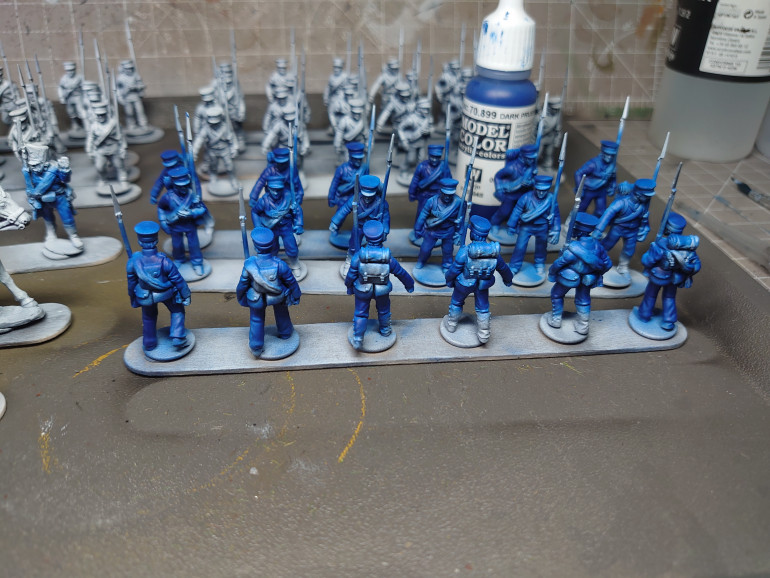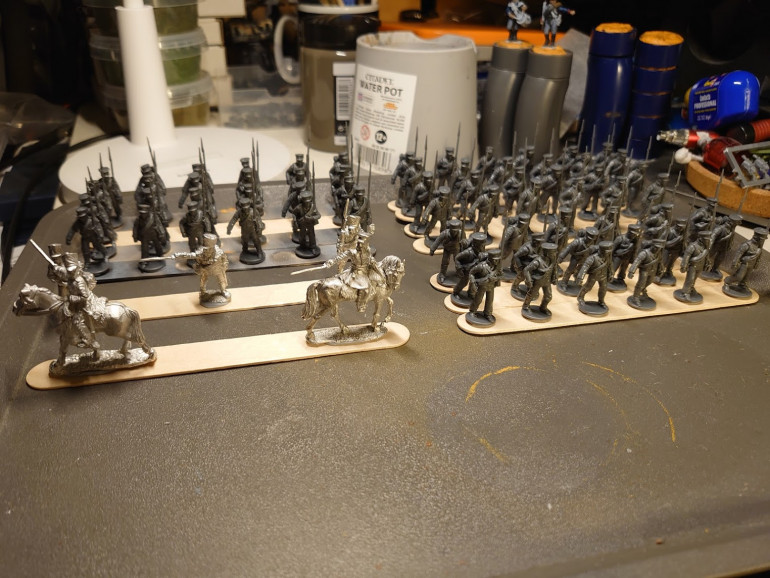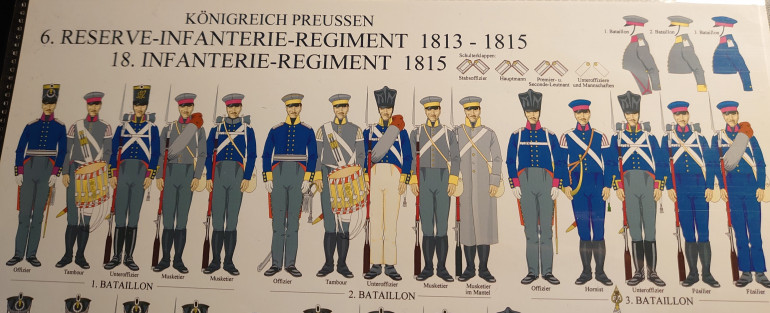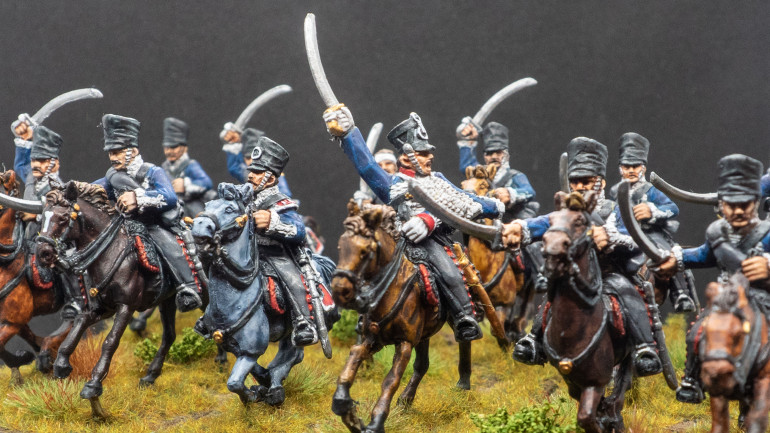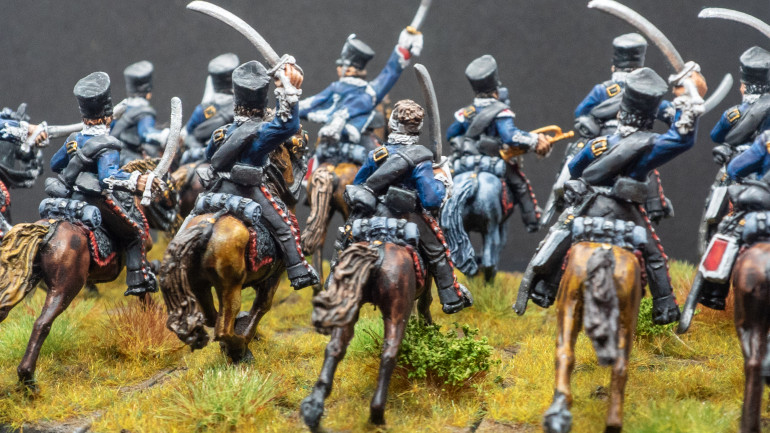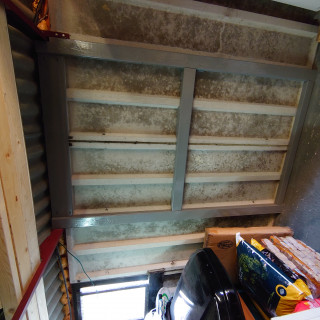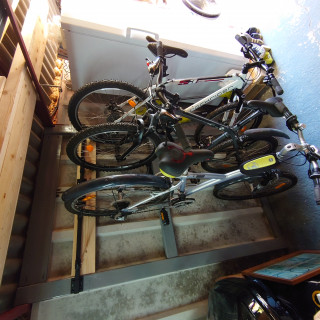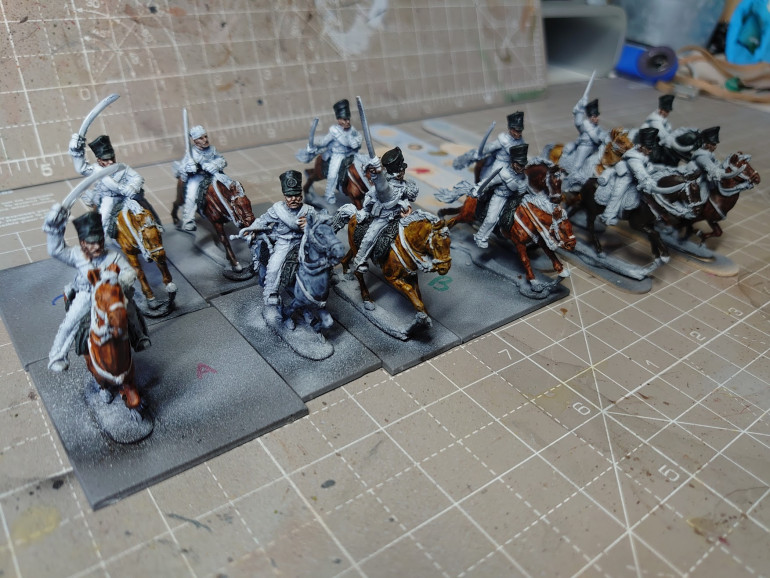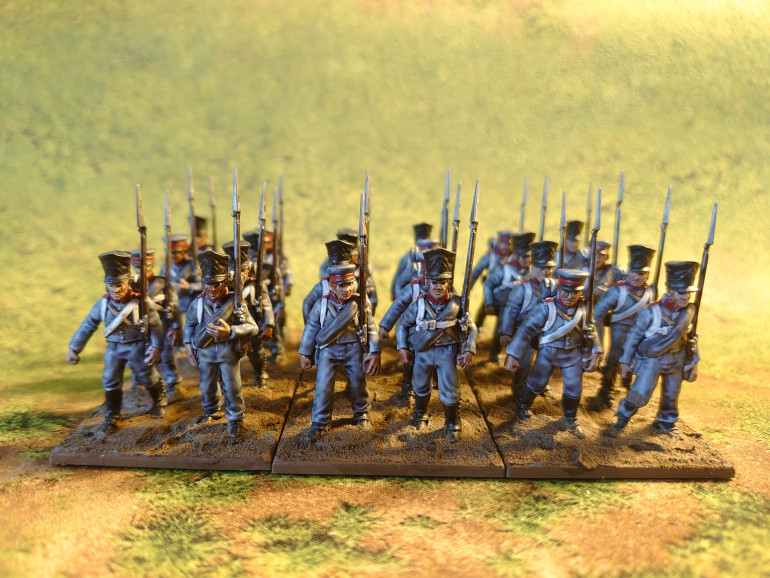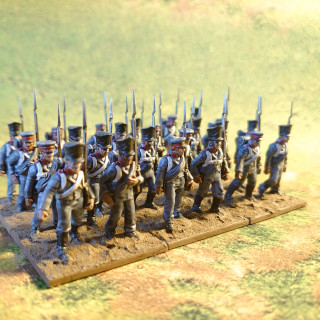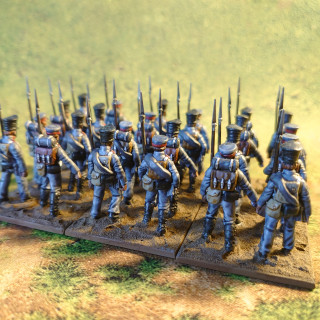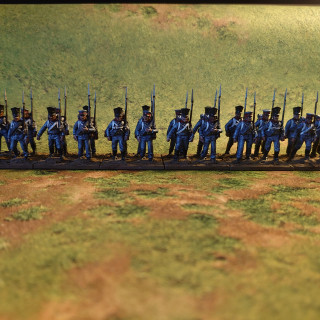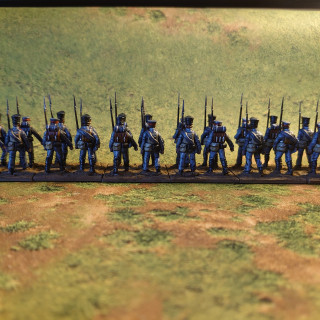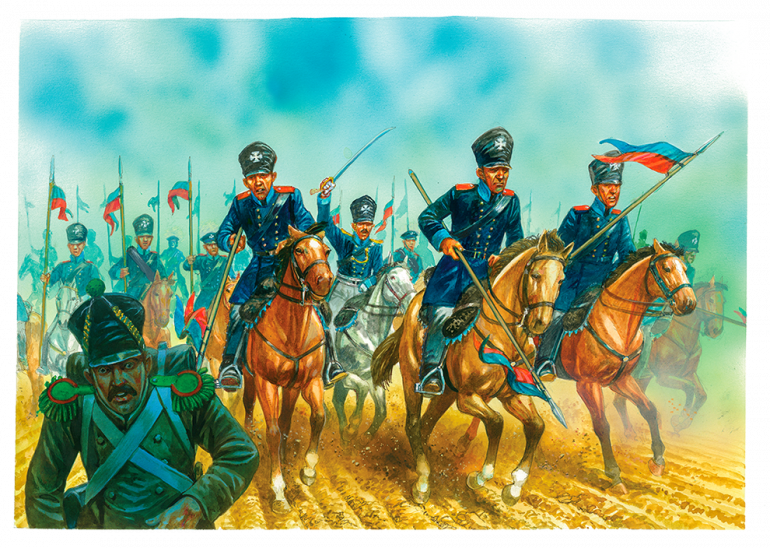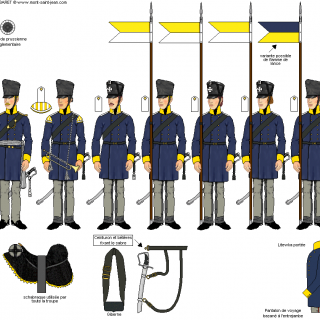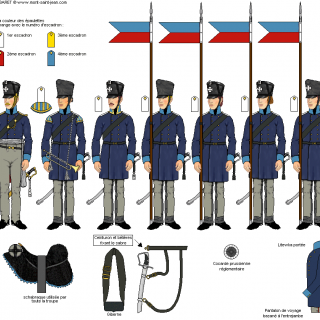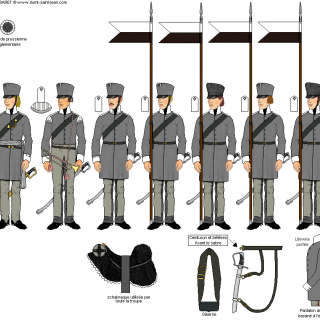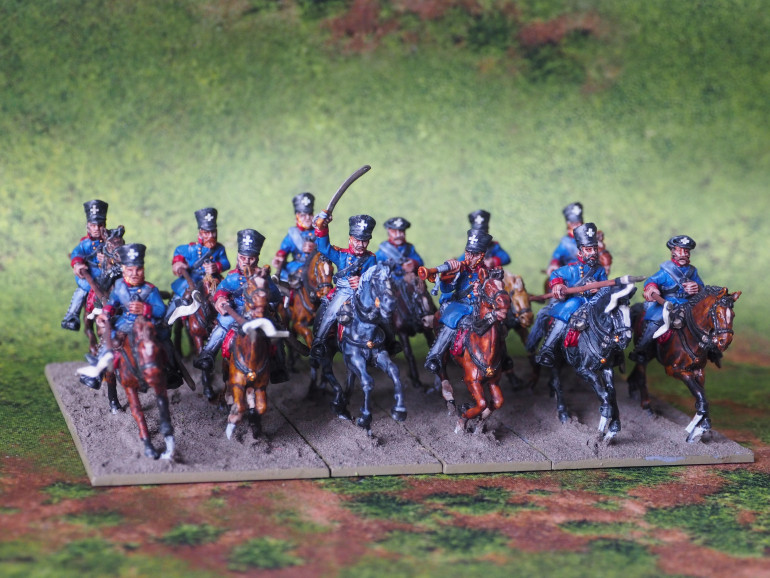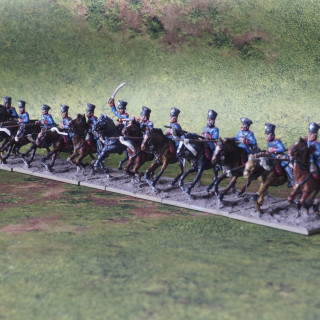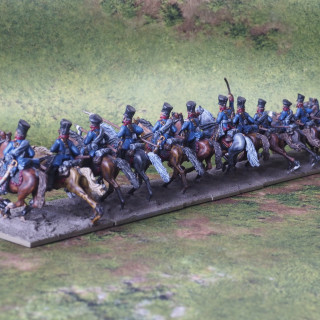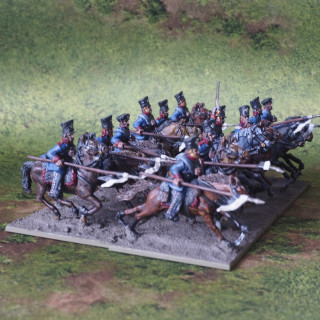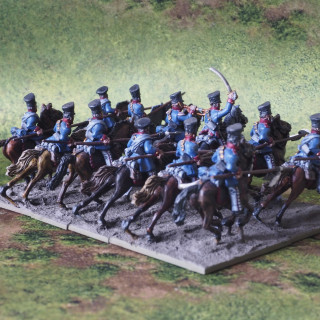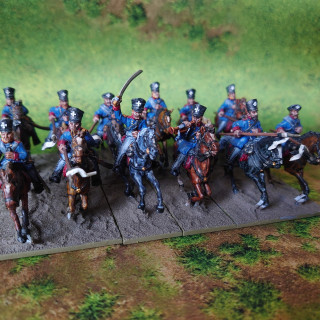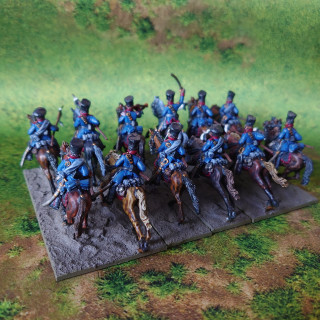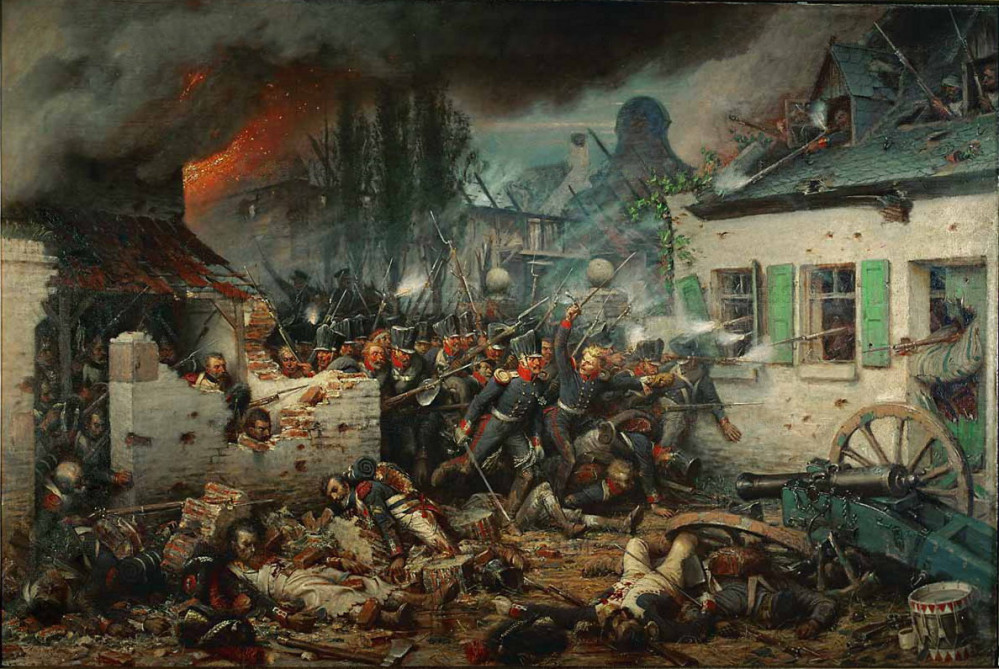
Raise high ze black flags my children! – The Prussian Army of 1813-1815
Recommendations: 886
About the Project
Building a 28mm Prussian Napoleonic army that can be used across a number of campaigns from 1813 upto the hurdred days and Waterloo.
Related Game: Black Powder
Related Company: Warlord Games
Related Genre: Historical
Related Contest: Spring Clean Hobby Challenge 2023
This Project is Active
Lützen 1813 General D'Armee Demo Gameat Partizan 2023
Better late than never, here’s some footage that finally made it out of the editing room.
Sadly its the only footage I got of this Year’s Partizan show, mostly as I was busy playing and putting on this demo game with other members from the club.
These are the few shots I managed to get towards the end of the day as the game came to its conclusion.
Partizan 2023 Complete
The project has been a bit quiet over the last few months despite me frantically painting a whole host of miniatures for it. The reason? My local club (Sheffield & Rotherham Wargames Club) decided to put on a game of General D’armee at this years Partizan.
For the game we chose to put on a scenario from the new 1813 Campaign book, in this case the Lutzen scenario. This resulted in a need for many many more miniatures to be painted.
Our initial setup of the table on the day ready and waiting for the crowds to arrive. We tweaked the scenario layout sightly based upon a combination of historical maps, satellite imagery and the scenery we have available.
The battle progresses, the Prussians struggled with hesitant brigades on the two flanks, resulting in a slow start. In the center they managed to take Gross-Gorshen from the French and just cling onto it throughout the game. The left flank sees some success managing to slowly push the french back but suffering high casualties in doing so.
Converting a Prussian Grenadier kitbash
One of the units I find myself needing is one of the Prussian Grenadier battalions. These where formed by combining the Grenadier companies of the various line regiments across the Prussian army. Generally these where organised in the same way, there being a battalion for each province, in this particular case I’m interested in the Silesian Grenadier Battalion.
These wore the same uniform as their line infantry counter parts with one exception a plumed shako, in Russian style was worn by Grenadiers, however on campaign this was covered in a oilskin just like everyone else. On one hand this is great for gamers, no need for specialised miniatures, on the other hand its a bit of a problem as there’s no easy way to distinguish them on the table. Its also quite nice as a hobbyist to paint something a bit different that has the added benefit of working on the table top.
Armed with an example image and a desire to do something different I then got thinking how this could be done.
First attempt
No manufacturer that I know of makes either the grenadier head or a specific set except possibly elite figures.
With the Prussian uniform being effectively a copy of the Russian uniform a source of parts was pretty easy to find. Enter the Perry Russian Infantry kit, which conveniently I had three sprues laying around for and a nice made in Sheffield Swann-Morton scalpel.
Now the downsides, each sprue only comes with two of the older pattern grenadier heads that would work for this kitbash, for a full battalion i’ll need 16 sprues worth!
The Russian plume is quite a bit taller in appearance so I’ll have to cut these down and reduce the height.
I’ll also have to remove the various coverings on the shako, cords etc. and paint on the brass plate on the front.
Overall though I think this first attempt works rather well?
Back, and Bigger!
After a big break in 2022 the project is back, and bigger and hopefully better than ever.
The spring clean challenge seems like the perfect time to be progressing the project with my Napoleonic mojo clearly back what better than to break out masses of Prussians! That and a tight deadline of a demo game at Partizan 2023!
Batch painting, go big or go home
A small insight into how I’ve been approaching the project so far, generally I fully assemble, clean-up, remove mould lines a whole regiment at a time, in the past this has been 3 battalions each consisting of 24 figures, 4 figures to a 40mm base, and 6 bases to a battalion.
This has mostly remained the same, this time I’m focusing on a line infantry regiment, either to be the 1st or 2nd Silesian however I’ve made a change to basing and figure count, moving from 40mm square to 60x40mm, and only 4 bases, I’ve also increased the figure density, to 8 figures per base, leaving me with a battalion of 32 figures. To round this up to a bigger unit of 5 bases, I’ve added a small 45x40mm skirmish stand to the musketeer battalions, which will be useful for games such as Soldiers of Napoleon. Overally this gives a much denser look to the units, which I prefer, and something I’ve also adopted with cavalry, but more on that in a later post.
The result of this is I’ve given myself a tight deadline, and increased the number of figures to paint by 50%, wish me luck!
Progress has been made, updates incoming!
Progress has been somewhat slow over the last month due to work being busier than normal.
I have however completed painting the 3 battalions of the 6th Prussian Reserve Infantry Regiment, basing is still required however I’m planning on doing this in bulk.
Alongside the Wargames Atlantic Plastics and Perry Metal Command figures I’ve also painted a mounted office by Calpe, a fantastic figure, mounted this fits in very well with the WA figures and the sculpting is fantastic, with no mold lines or cleanup required and a joy to paint
New set of paints to try, Vallejo Game Color Extra Opaque
Having experimented with airbrushing miniatures in their primary base colour I hit a problem of coverage. Some paints really don’t work well over the blue without a few layers, this usually wouldn’t be a huge problem, but when painting a large batch this quickly starts to double the painting time.
Culloden Painting Studio (a great youtube channel you should subscribe to) recently did a video that couldn’t have been better timed following the coloured prime idea. While my overall painting plan is a bit different he did use these “extra opaque” heavy game colour paints and I felt it would be worth a go.
Having found 3 or so colours I thought I’d like I quickly realised the cost put me off a bit, buying 3 paint generally ends up costing the same again in postage, so I decided to buy the full set of 16 for £33 off Amazon (I normally use a smaller store but in this case, I wanted to crack on).
So far I’ve been reasonably impressed, I’ve used several as base colours and all have covered well with one coat, I’ll be following up with another update once I’ve finished the Batallion and sharing some more thoughts on these paints but initial impressions are good and these look like a great timesaver.
Priming en Masse, and going slightly further with the airbrush
I’ve now primed up the assembled 6th Reserve Regiment (minus some additional command).
I moved away from spray can’s to an airbrush for priming miniatures a few years ago and haven’t really looked back. Despite some early issues I’ve now got a pretty good system for priming my miniatures and it worked really well here.
As in the previous post, I assemble the miniatures and use blue-tac (poster tac) to stick them to tongue depressors (lolly sticks). Generally I try and get one sprue per stick, so six figures, in this case, this just provides a really simple way to check for duplicates when assembling.
Above are the three main stages I follow, these are:
- Initial prime with Vallejo Surface Primer Black
- Once this has dried (I usually give it a good hour) I follow this with a second prime of Vallejo Surface Primer Grey, this time with lighter passes and at a 45-degree angle, this leaves a good amount of back on the undersides and shadows.
- Finally, I follow on with a very quick highlight of Liquitex White Ink, from almost vertical, with a quick pass on the front and back.
I struggled for quite a while when first using an airbrush with it clogging, while I still have some issues, I’ve managed to overcome these with a few actions.
- Give it a good clean after use, I generally rinse the cup with water to remove any paint, then I run one or two cups (the bit you put the paint in) of clean water through it followed by around half a cup of airbrush cleaner.
- For the Vallejo primers, I used them at first out of the bottle, I’ve found that adding in thinner and most importantly a few drops of flow improver helps this massively, I don’t know the exact ratios but I have not more than 1/3 thinner and flow improver, maybe as little as 1/4, i also give these a good stir in the airbrush cup.
Wanting to stretch the bounds of my airbrush skills a bit I decided to basecoat the third battalion, who have a full blue uniform, using the airbrush.
I think the result looks very effective and really shows the benefit of zenithal priming. Hopefully, this will continue to look good as I start painting the miniatures.
A small update: Start of the next wave, the Prussian 6th Reserve
Progress on this project has slowed somewhat over the last month, alongside summer I also decided to do something a bit different and started a small War of the Roses project.
Over the weekend I managed to clip, clean mould lines and assemble enough Prussian Reservists from Wargames Atlantic for the 6th Prussian Reserve Regiment. I’m using Perry Miniatures Prussian Reserve Command, alongside a few Mounted officers from both the Perry’s and Calpe. I’m just waiting on some additional command figures from the Perrys to arrive to round out the regiment.
After painting several units as part of this project so far I wanted to narrow down my focus and work on a historical formation.
This is a pretty big chunk of miniatures, and quite ambitious trying to complete a full regiment in a go. I’m looking forward to the end result and I’m staying positive about the challenge of painting this many miniatures.
There are several somewhat unique elements to this regiment that resulted in me selecting it. I’d previously picked up several Uniform Plates by Peter Bunde as you can see earlier in this project, somewhat randomly. The low-resolution previews give you a rough outline but the physical plates are much clearer and include a very handy history sheet as well, with the 6th notably taking part in the Battle of Leipzig and stormed Plancenoit at Waterloo (by which time it was renamed the 18th Infantry Regiment).
It appears to be one of the few regiments to mostly wear variations of the reservist uniform, with all three battalions issued it. This handily means I can maximize the use of the Wargames Atlantic kits.
The 6th was an amalgamation of 2 west Prussian and a Silesian reserve battalion, hence the mixed facing colors of pink and yellow. All three battalions participated in engagements, there being no “depot” battalion as seen in other armies.
The 3rd battalion would be the fusilier/light battalion, in this case, distinguished by the full blue uniform, generally, these wore black belts but in this case, it’s the standard white.
From what I understand the cap was often quite quickly replaced with the shako in quite a few of the reserve units so this probably isn’t the most accurate but I think wearing all caps will give the regiment a somewhat unique feel on the tabletop.
If anyone knows where I can get some additional command figures in a size that roughly fit in with the wargames Atlantic/Perrys that would be amazing. I’m using Perry’s Prussian reserve command, and have one or two Calpe NCOs I may mix in that scale about the same.
I’d quite like a drummer wearing a cap in the reservist uniform, I’m also struggling for the hornist of the 3rd Battalion, I might have to fall back to a standard fusilier one.
Prussian Hussars
I showed a seek preview of these in progress a few weeks ago and completed them shortly afterward, having thoroughly enjoyed painted them much to my own surprise.
These can be used to represent a number of Prussian Hussar regiments, several wore the dark Prussian blue and had red facings. I’ve used the illustrations in Osprey Publishings Prussian Cavalry of the Napoleonic Wars (2) as a guide and imagine these being played mostly as one of the Brandenburg Hussar Regiments.
My love/hate relationship with Warlord “resin” continues, thankfully I picked this set up (and another) off eBay for about £15 each, which makes it much more palatable. At £27 RRP, these are getting too close to the price of metals for what I class as an inferior material.
Sculpting wise these are actually rather good once completed, the detail is quite defined, and although the riders are all single piece as a unit there’s enough variety to make it interesting.
The horses are still on the skinny side compared to the likes of the Perry’s but they don’t stand out too much and I’ll mainly be using this with other Warlord Prussian Cavalry until the Perry’s release the Plastic Dragoon kit!
I continued with my contrast method when painting the horses but changed over the paint triad system for the riders and I think it really shows.
Overall I think these are by far the best-painted miniatures I’ve done to date and it’s nice to look back and see the progress.
Showcase Video of Wargames Atlantic Prussian Reserve
Here’s a closer look at the Wargames Atlantic Prussian Reserve, I’ve now started the process of basing them up and it really brings the miniatures to life.
This is the second video I’ve edited up, now with glorious 60 frames a second after I found the right export setting. Think I’m finally getting back into the flow of video editing after many years away, I’m actually quite enjoying it. I’ve got a few more units lined up for these showcase style videos out of the Prussians that I’ve completed previously then I’m going to have to start painting things again
New Youtube Channel with showcase of completed Artillery
This is something I’ve been wanting to do for a while and I finally cracked, got my camera gear out, picked up a greenstuff world photo booth and one of those cheap turntables.
The end result I think is pretty effective and a process I really enjoyed, despite spending the best part of the evening getting used to video editing again. Its also been a great chance to get some much better quality photos.
I’ll be using these videos to add something extra to the project posts but I’m also planning on adding other content to the channel as time allows.
As for the minature, this is the same as in previous updates but with the addition of basing, I’m really happy with the results and will have a full update in a future post on how I based this and other minis. Its a simple scheme that looks effective maybe one or two addtions will make their way in.
Updates are inbound
This project’s been a bit quite over the last month but updates are inbound.
My main hobby update will be a completed unit of Prussian Hussars by Warlord Games, quite possibly the best looking unit ive yet painted and very enjoyable after a bit of a hobby break.
Alongside that I’ve started basing up the completed units, this was suprisingly quick and I think I’ve got a nice and simple process, minus drying times its pretty time efficient. I just need a few more finishing touches but its really tying the force together and gives them that finished look.
I’ve finally cracked out my camera gear and decided to take some good quality photos of the end results, I’ve even taken a few videos which will be going up onto youtube.
Here’s what I’ve got planned as project updates for the next few weeks (hopefully with time permitting)
- A Wargames Guide to Prussian Reserve Infantry
This will be similar to the previous guide to Landwehr Cavalry, its about 60% complete. - Warlord Games Prussian Hussars
This unit is painted up and based, photos have been taken and im in the process of writing my process up. - A Wargames Guide to Prussian Hussars
This thankfully is simplier than the previous guides and I hope to have this together quite quickly - Basing Update
I’ve finally started looking at basing some of my painted units, I’m really happy with the results so far.
I’d also like to say a big thankyou for everyone who’s been following the project along, and the beasts of war team for both the Golden Button and the nomination for the spring clean tutorial. Its rewarding enough to share my hobby with others, its extremley satisfying to know that others are both intrested in it and have found it valuable, its a huge motivation to keep this project going.
Bit of a Hobby Break
Been having a bit of a break from the hobby and the wider community for the last few weeks, actually probably last few months. Only really chiping in on OTT news articles and occasionally checking discord. Partly as I needed a break and also due to work, and that sun thing outdoors. I actually feel better for it in all honesty.
One of the things I did was this quick project, a wooden frame attached to side of concrete garage for storing bikes vertically to free up space. Made a bit more interesting and tricky as the concrete is impossible to drill so some clever use of existing holes was required.
Anyway I had last Thursday afternoon off and did a quick couple of hours hobby and after having that break I thoroughly enjoyed it for a change. A bit of an important reminder that is easy to get drawn into something too much and its good to sometimes take a step back.
Random Ramblings - Hobby Test Stream
Recently I thought I would give this streaming thing a go and did a short test stream over on twitch mainly to try the format out.
It was quite fun chatting away while doing some hobby enough so that I’ve got the bug. Area’s for improvement aplenty.
This includes’s quite a bit of rambling on about Prussians, and some comparisons of sprue’s and minatures from various manufacturers.
1st Battalion of Prussian Reserve by Wargames Atlantic Complete
This is the first battalion of Prussian Reserve by Wargames Atlantic that I have completed and I’m very happy with the results.
In its current form (24 figures) this battalion is missing command figures which i’m currently working on using the metal Reserve Command from Perry Miniatures.
I’ll be following up with a more detailed post on the history and organisation of the reserve battalions/regiments. The red facings on these should allow them to be used for a range of regiments, im yet to decide on which at this point in time, worth noting is the reserve battalions were not issued flags (as far as i can tell) which makes these very flexible in terms of representing a wide range of regiments on the tabletop.
In terms of research these are very interesting, a wide range of uniforms were issued and changed over the course of the Napoleonic Wars, the provisional grey uniform being issued, alongside the standard prussian line uniform, british/portuguese uniforms and even salvaged french equipment in cases.
The reserves were later “converted” to full line regiments in 1815, by that point being issued the full Prussian Uniform but this hadn’t come into full effect by the 100 days campaign.
These figures are sculpted wearing the provisional grey uniform, in some cases this was dyed the more traditional prussian blue which I shall be doing for some battalions.
The miniatures as previously stated are fantastic, both in terms of sculpting and value. I’ve actually ordered a second box from my FLGS.
For this unit I took the “speed” painting approach using very simple techniques which I think has been very effective.
- Prime
Scale 75 Instant Colours Primer Ice Charm (or Vallejo Gray Surface Primer) - Boots, shakos, cap peaks, cartridge box
Citadel Black Templar Contrast - Trousers and Jackets
Citadel Space Wolves Grey - Packs – Mixed
Citadel Black Templar Contrast
Citadel Gore Grunta Fur Contrast
Citadel Skeleton Horde Contrast
Citadel Snakebite Leather Contrast - Flesh
Citadel Gulliman Flesh Contrast - White Belts
VallejoModel Colour Off-White - Pack Belts
Scale 75 Gobi Brown - Coats and Rolls
Vallejo London Grey, followed by a Wash of Citadel Nuln Oil - Unit Facings (in this case Red)
Vallejo Game Colour Gory Red - Musket
Citadel Wildwood Contrast - Metalwork
Scale 75 Thrash metal - Buttons
Citadel Retributor Armour - Wash (All areas except flesh)
2-1 of Army Painter Quickshade mixing medium / Army Painter Dark Tone
This is actually a pretty quick step by step painting guide, the final wash really ties the scheme together.
A Wargamers Guide to Prussian Landwehr Cavalry
First off a disclaimer, the intention of this guide is to provide wargamers a point of reference when it comes to using Prussian Landwehr Cavalry in their games. While I’ve tried to research and be as accurate as possible the intention here is to provide enough information to guide and inform choices on the tabletop.
Formed in March 1813 the Landwehr Cavalry was a large mounted militia force raised in a similar way to the Landwehr Infantry and consisted of 30 regiments, raising to 34 in 1815.
A Regiment would consist of 4 squadrons of 72-100 men (the exact number varies depending on the source but generally falls into this ballpark) and the command staff. These squadrons would then be further split in 4 platoons.
Regiments were raised in each province of Prussia, the number of regiments varying in each, the most numerous being those from Kurmark, Silesia and East Prussia, probably the most recognisable to a wargamer from their red and yellow facings being common on artwork.
- East Prussia – 5 regiments
- West Prussia – 3
- Pomerania – 3
- Neumark – 2
- Kurmark – 7
- Silesia – 8
- Westphalia – 1
- Elbe – 1
- Rhineland – none (3 regiments after November 1815)
They saw action throughout the 1813-1814 campaigns with some excellent engagements, which you can read more about in the sources, generally brave and reckless to abbadon they were undisciplined, poorly trained and equipped but enjoyed several successes.
During a charge, they were brave to the point of forgetting all obedience and order; during a retreat, on the contrary, after a charge that had been repulsed, only natural obstacles were, as a rule, able to stop them.
The battle of Leipzig gives a good example of how the Landwehr were deployed, with most infantry brigades seeing 1 or 2 squadrons attached and a Landwehr cavalry briage making up part of each crops cavalry reserve.
Allied order of battle at Leipzig
During the hundred days campaigns the Landwehr Cavalry made up 40% of the Prussians cavalry.
Uniforms and Equipment
Cavalrymen wore a dark blue Litewka (Long Coat) and were armed with a Lance and curved Sabre.
Belts and leatherwork would be black, buttons either white/yellow and collars and cuffs in provincial colours. Headwear was a covered shako with the white cross.
From a painting perspective these are very similar to the Landwehr infantry, the main distinctions being the addition of the lance pennon which varied across provinces and regiments and of course the horses.
The following table gives an overview of provincial colour diferences.
|
Province
|
# of Rgts
|
Collar/Cuffs
|
Buttons
|
Lance Pennons
|
|
East Prussia
|
5
|
Poppy Red
|
White
|
red/white
|
|
Kurmark/Neumark
|
2/7
|
Poppy Red
|
Yellow
|
white/black
|
|
West Prussia
|
3
|
Black *
|
White
|
yellow/crimson
|
|
Pomerania
|
2
|
White
|
Yellow
|
white/black
|
|
Silesia
|
8
|
Yellow
|
White
|
white/yellow
|
|
Westphalia
|
1
|
Green
|
White
|
orange?
|
|
Elbe
|
1
|
Light Blue
|
Yellow
|
blue/red
|
|
Rhineland
|
0/3
|
Madder Red
|
Yellow
|
white/crimson
|
The following plate gives an example of the uniform worn by the 4th Regiment of Kurmark Landwehr Cavalry. Note the white and black lance pennon. Epaulettes varied based on the squadron within the regiment, in this case white being the 1st squadron, the unit I’ve previously painted had red epaulettes and would represent the second squadron.
The following plates give examples of how the uniform varies based off regiment, these are all taken from the excellent resource http://centjours.mont-saint-jean.com/unitesPR.php
In Games
In Black Powder Landwehr Cavalry are covered in Albion Triumphant Volume 2 – The Hundred Days Campaign.
Two options are available for fielding based off The Prussian Army, 1815 List:
0-1 Small Landwehr Cavalry Regiments can be taken as Brigade Support for Each Prussian Infantry Brigade.
This represents the role the Landwehr Cavalry played well, with the often being split into smaller formations and attached to Infantry to provide support, reconnaissance and scouting duties.
As a landwehr Cavalry Brigade (1 per two infantry brigades)
This formation allows you to field a brigade of Landwehr Cavalry consisting of 2 to 5 Regiments plus the option for Horse artillery support. This allows you to field a large mass of cavalry which represents the Cavalry Reserve of a Corps.
Sources
The following are a collection of sources I used in creating this guide, these may also be useful in your own research.
- Osprey MAA 192 – Prussian Reserve Militia & Irregular Troops 1806-15
- Prussian Landwehr Cavalry, 1813
https://blundersonthedanube.blogspot.com/2013/05/prussian-landwehr-cavalry-1813.html - Landwehr Cavalry [Landwehr Kavallerie] and the National Cavalry Regiments.
http://napoleonistyka.atspace.com/Prussian_cavalry_Napoleon.htm#_Landwehr - Les troupes prussiennes
http://centjours.mont-saint-jean.com/unitesPR.php
Prussian Landwehr Cavalry
Completed at last Prussian Landwehr Cavalry by Warlord Games. A paint in the ** to assemble but an joy to paint.
As I’ve enjoyed doing my research these would represent one of the regiments of the Province of Kurmark/Neumark and be the second squadron (i think).
If you want to button count then the red is closer to madder red than poppy red so would actually be closers to a regiment from Rhineland province, however the Lance Pennons are the white and black of Kurmark/Neumark. The button would be yellow in either case.
Also the prussian blue uniform is probably too bright but who cares, these are toy soldiers afterall. Still yet to decide on basing.
Im still undecided on warlord “resin”, its annoying to work with as its plasticly without being plastic. Sculpting wise these are actually pretty reasonable I think, the detail is quite good and they work great with contrast paints. The Assembly was a pain as the getting the riders onto the horses was nearly impossiable as they dont fit in the saddles, add to that you need to align the lance and the bases wont be flat until you glue them to something it becomes a pretty momumental challenge. One benefit of the resin is the lances are nearly impossible to break (I know this from dropping them from my desk and landing tip first) as are the horses ankles.
Overally I’m actually Quite happy with these,
More Research material has arrived
I decided to pick up a few of of Peter Bunde’s Brigade plates from Calpe Minatures. I somewhat randomly picked the 1st, 6th and combined 11th 12th Prussian Reserve regiment plates.
I’d found the Osprey Books a bit limiting when it comes to good quality imagery, there majority is black and white, the few colour plates are not the best print quality and given their range of content they only cover limited uniforms.
These are a bit pricey in all fairness but I really enjoy having a physical reference. The illustrations are very similar to those you find included with Perry Miniatures and are a great resource.
I found these particularly interesting as they cover in more depth a regiment and its battalions, In the case of the Prussian reserve regiments there was a huge variation in uniforms and these plates capture it well.
There’s also a very detailed page on the reverse with that units history and battles etc. which is equally useful as a guide when considering tying units into historical formations and actions.
Further Reading and Research has arrived
Following Napoleons retreat from Moscow in 1812 he was significantly weakened (but not out) in his power in europe. This saw Prussia, once a begrudging allly of France turn into an enemy along side an equally weakend Russia, while Napoleon rebuilt his forces. Several battles being fought with Napoleons freshly raised armies as part of the 1813 German Campaigns resulting in Austria which had been sitting on the sidelines finally joining the coalition forces.




































